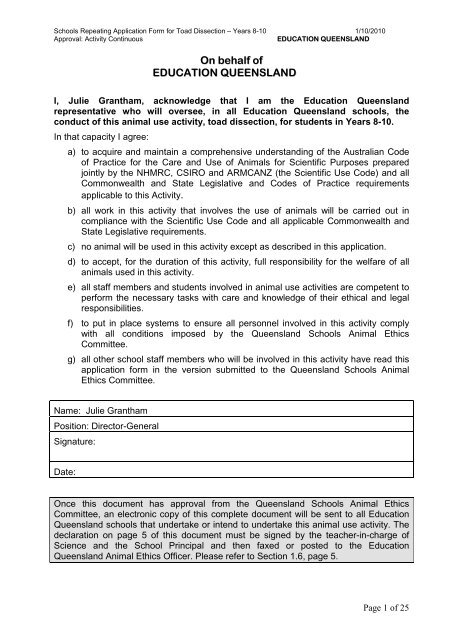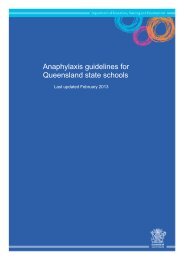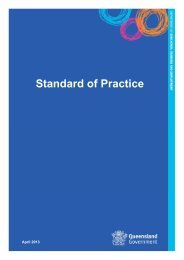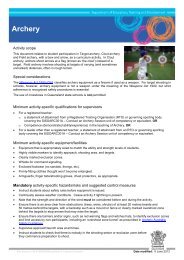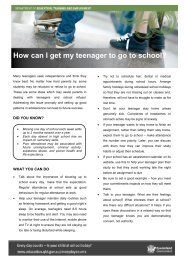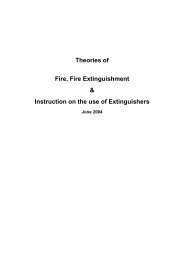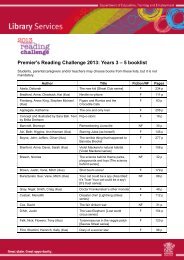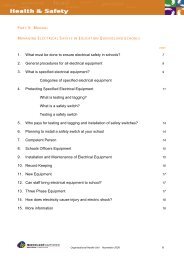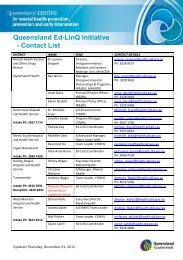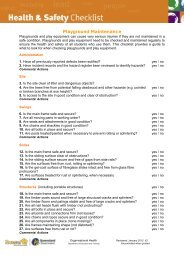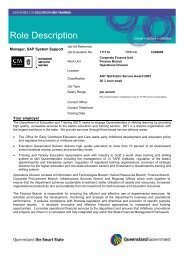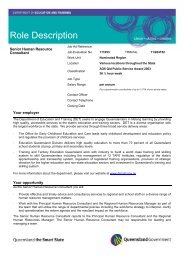Toad Dissection for Years 8 to 10 - Education Queensland
Toad Dissection for Years 8 to 10 - Education Queensland
Toad Dissection for Years 8 to 10 - Education Queensland
You also want an ePaper? Increase the reach of your titles
YUMPU automatically turns print PDFs into web optimized ePapers that Google loves.
Schools Repeating Application Form <strong>for</strong> <strong>Toad</strong> <strong>Dissection</strong> – <strong>Years</strong> 8-<strong>10</strong> 1/<strong>10</strong>/20<strong>10</strong><br />
Approval: Activity Continuous EDUCATION QUEENSLAND<br />
On behalf of<br />
EDUCATION QUEENSLAND<br />
I, Julie Grantham, acknowledge that I am the <strong>Education</strong> <strong>Queensland</strong><br />
representative who will oversee, in all <strong>Education</strong> <strong>Queensland</strong> schools, the<br />
conduct of this animal use activity, <strong>to</strong>ad dissection, <strong>for</strong> students in <strong>Years</strong> 8-<strong>10</strong>.<br />
In that capacity I agree:<br />
a) <strong>to</strong> acquire and maintain a comprehensive understanding of the Australian Code<br />
of Practice <strong>for</strong> the Care and Use of Animals <strong>for</strong> Scientific Purposes prepared<br />
jointly by the NHMRC, CSIRO and ARMCANZ (the Scientific Use Code) and all<br />
Commonwealth and State Legislative and Codes of Practice requirements<br />
applicable <strong>to</strong> this Activity.<br />
b) all work in this activity that involves the use of animals will be carried out in<br />
compliance with the Scientific Use Code and all applicable Commonwealth and<br />
State Legislative requirements.<br />
c) no animal will be used in this activity except as described in this application.<br />
d) <strong>to</strong> accept, <strong>for</strong> the duration of this activity, full responsibility <strong>for</strong> the welfare of all<br />
animals used in this activity.<br />
e) all staff members and students involved in animal use activities are competent <strong>to</strong><br />
per<strong>for</strong>m the necessary tasks with care and knowledge of their ethical and legal<br />
responsibilities.<br />
f) <strong>to</strong> put in place systems <strong>to</strong> ensure all personnel involved in this activity comply<br />
with all conditions imposed by the <strong>Queensland</strong> Schools Animal Ethics<br />
Committee.<br />
g) all other school staff members who will be involved in this activity have read this<br />
application <strong>for</strong>m in the version submitted <strong>to</strong> the <strong>Queensland</strong> Schools Animal<br />
Ethics Committee.<br />
Name: Julie Grantham<br />
Position: Direc<strong>to</strong>r-General<br />
Signature:<br />
Date:<br />
Once this document has approval from the <strong>Queensland</strong> Schools Animal Ethics<br />
Committee, an electronic copy of this complete document will be sent <strong>to</strong> all <strong>Education</strong><br />
<strong>Queensland</strong> schools that undertake or intend <strong>to</strong> undertake this animal use activity. The<br />
declaration on page 5 of this document must be signed by the teacher-in-charge of<br />
Science and the School Principal and then faxed or posted <strong>to</strong> the <strong>Education</strong><br />
<strong>Queensland</strong> Animal Ethics Officer. Please refer <strong>to</strong> Section 1.6, page 5.<br />
Page 1 of 25
Schools Repeating Application Form <strong>for</strong> <strong>Toad</strong> <strong>Dissection</strong> – <strong>Years</strong> 8-<strong>10</strong> 1/<strong>10</strong>/20<strong>10</strong><br />
Approval: Activity Continuous EDUCATION QUEENSLAND<br />
SCHOOL: EDUCATION QUEENSLAND<br />
Postal Address: PO Box 15033, City East, Q 4002<br />
APPLICATION TO USE ANIMALS IN EDUCATION<br />
FOR SCIENTIFIC PURPOSES<br />
(EXTERNAL TO DEPARTMENT OF PRIMARY INDUSTRIES)<br />
Section 1 Details of the proposed animal use activity<br />
1.1. Activity Title<br />
<strong>Toad</strong> <strong>Dissection</strong><br />
1.2. Objectives of the proposed animal use activity<br />
1.2.1. This activity is proposed <strong>for</strong>:<br />
Students from <strong>Years</strong> 8-<strong>10</strong> studying Science<br />
1.2.2. This proposed animal use activity has the following stated<br />
outcomes:<br />
To achieve core learning outcomes in the Life and Living Strand of the <strong>Years</strong><br />
1-<strong>10</strong>, Science Syllabus, 1999. These are:<br />
4.1 Students examine the internal and external structures of living things.<br />
5.1 Students collect in<strong>for</strong>mation about the structure and function of living<br />
things.<br />
To enable students <strong>to</strong> develop the attributes of a lifelong learner as an active<br />
investiga<strong>to</strong>r (Science Syllabus, 1999) through direct involvement in dissection<br />
and observation.<br />
To enable students <strong>to</strong> ‘work scientifically’ by collecting in<strong>for</strong>mation and handling<br />
materials (Science Syllabus, 1999) in a ‘real life’ situation as experienced in<br />
dissection and observation.<br />
1.2.3. Format of the proposed animal use activity:<br />
Activity per<strong>for</strong>med by students with supervision Yes No<br />
Activity per<strong>for</strong>med by students without supervision Yes No<br />
1.2.4. Does the proposed animal use activity offer opportunities <strong>for</strong><br />
students <strong>to</strong> discuss the ethical, social and scientific issues involved<br />
in the use of animals <strong>for</strong> scientific purposes?<br />
Yes No<br />
Page 2 of 25
Schools Repeating Application Form <strong>for</strong> <strong>Toad</strong> <strong>Dissection</strong> – <strong>Years</strong> 8-<strong>10</strong> 1/<strong>10</strong>/20<strong>10</strong><br />
Approval: Activity Continuous EDUCATION QUEENSLAND<br />
This activity allows <strong>for</strong> class discussion of a range of ethical and social issues related <strong>to</strong><br />
animal rights, the principles of reverence <strong>for</strong> life, stewardship and the use of animals <strong>for</strong><br />
experimentation.<br />
Students who do not wish <strong>to</strong> participate in using animals in this scientific procedure will<br />
be provided with alternative tasks that provide them with similar knowledge and do not<br />
disadvantage their studies in this <strong>to</strong>pic.<br />
1.3. Status of Application<br />
1.3.1. What is the current status of this application?<br />
Resubmission of the <strong>Education</strong> <strong>Queensland</strong> <strong>Toad</strong> <strong>Dissection</strong> application<br />
approved in 2006.<br />
1.3.2. What is the <strong>to</strong>tal period of approval sought by this application?<br />
Up <strong>to</strong> 3 years.<br />
1.3.3. Has this application been considered by another Animal Ethics<br />
Committee (AEC)?<br />
Yes No<br />
1.4. Expected commencement and completion dates of the proposed animal<br />
use activity.<br />
Expected Commencement Date Expected Completion Date<br />
Activity continuous<br />
Term 2, 20<strong>10</strong><br />
Activity continuous<br />
Term 3, 2013<br />
1.5. Details of school/s or college/s seeking approval <strong>for</strong> the proposed animal<br />
use activity.<br />
1.5.1. Name all schools / colleges<br />
undertaking this proposed animal use<br />
activity.<br />
<strong>Education</strong> <strong>Queensland</strong> schools offering<br />
Science <strong>for</strong> <strong>Years</strong> 8-<strong>10</strong>. See attached<br />
document detailing the <strong>Education</strong><br />
<strong>Queensland</strong> schools that undertake these<br />
Science programs.<br />
1.5.2. Description of school group <strong>Education</strong> <strong>Queensland</strong><br />
1.5.3. Year Levels <strong>Years</strong> 8-<strong>10</strong><br />
1.5.4. Area of studies Science <strong>for</strong> <strong>Years</strong> 8-<strong>10</strong><br />
1.5.5. DPI&F scientific user registration<br />
number<br />
0<strong>10</strong>2<br />
Page 3 of 25
Schools Repeating Application Form <strong>for</strong> <strong>Toad</strong> <strong>Dissection</strong> – <strong>Years</strong> 8-<strong>10</strong> 1/<strong>10</strong>/20<strong>10</strong><br />
Approval: Activity Continuous EDUCATION QUEENSLAND<br />
1.5.6. Is the class teacher/s conducting<br />
this proposed animal use activity<br />
considered competent with at least two<br />
years of practical experience in<br />
dissection activities?<br />
1.5.7. Anticipated number of <strong>Education</strong><br />
<strong>Queensland</strong> schools <strong>to</strong> be involved in<br />
this continuous <strong>to</strong>ad dissection<br />
activity.<br />
1.5.8. Anticipated number of <strong>Education</strong><br />
<strong>Queensland</strong> students <strong>to</strong> be involved in<br />
this continuous <strong>to</strong>ad dissection<br />
activity.<br />
1.5.9. Number of times this <strong>to</strong>ad<br />
dissection activity will be per<strong>for</strong>med<br />
during the Science <strong>Years</strong> 8-<strong>10</strong> program.<br />
Yes<br />
No<br />
300 <strong>Education</strong> <strong>Queensland</strong> schools per<br />
year<br />
Approximately 9000 students per year<br />
The option <strong>to</strong> participate in one <strong>to</strong>ad<br />
dissection will be provided <strong>to</strong> <strong>Education</strong><br />
<strong>Queensland</strong> school students, as they<br />
progress through <strong>Years</strong> 8, 9 and <strong>10</strong>, if this<br />
activity is part of the school’s Science<br />
program.<br />
PLEASE NOTE: Cane <strong>to</strong>ads may be kept without a licence or permit. However it is<br />
illegal <strong>to</strong> release a non-native animal <strong>to</strong> the wild.<br />
Complete your school’s plan <strong>for</strong> animal dissections.<br />
List the types of animal<br />
dissections undertaken in<br />
your school.<br />
Year Levels<br />
Year 8<br />
Year 9<br />
Year <strong>10</strong><br />
Year 11<br />
Year 12<br />
List the alternatives <strong>to</strong><br />
using animals that your<br />
school uses and has<br />
available.<br />
Page 4 of 25
Schools Repeating Application Form <strong>for</strong> <strong>Toad</strong> <strong>Dissection</strong> – <strong>Years</strong> 8-<strong>10</strong> 1/<strong>10</strong>/20<strong>10</strong><br />
Approval: Activity Continuous EDUCATION QUEENSLAND<br />
Declaration of authority <strong>to</strong> per<strong>for</strong>m this proposed animal use activity:<br />
<strong>Toad</strong> <strong>Dissection</strong> with students studying Science <strong>Years</strong> 8 <strong>to</strong> <strong>10</strong>.<br />
I, ___________________________, acknowledge that I am the teacher<br />
appointed/authorised teacher representative who will conduct this animal use<br />
activity at ____________________________________________________________.<br />
In that capacity I agree:<br />
(School/College name)<br />
a) <strong>to</strong> acquire and maintain a comprehensive understanding of the Australian Code of<br />
Practice <strong>for</strong> the Care and Use of Animals <strong>for</strong> Scientific Purposes prepared jointly by the<br />
NHMRC, CSIRO and ARMCANZ (the Scientific Use Code) and all Commonwealth and<br />
State Legislative and Codes of Practice requirements applicable <strong>to</strong> this Activity.<br />
b) all work in this activity that involves the use of animals will be carried out in compliance<br />
with the Scientific Use Code and all applicable Commonwealth and State Legislative<br />
requirements.<br />
c) no animal will be used in this activity except as described in this application.<br />
d) <strong>to</strong> accept, <strong>for</strong> the duration of this activity, full responsibility <strong>for</strong> the welfare of all animals<br />
used in this Activity.<br />
e) all staff members and students involved in animal use activities are competent <strong>to</strong><br />
per<strong>for</strong>m the necessary tasks with care and knowledge of their ethical and legal<br />
responsibilities.<br />
f) <strong>to</strong> put in place systems <strong>to</strong> ensure all personnel involved in the activity comply with all<br />
conditions imposed by the Animal Ethics Committee.<br />
g) all other school staff members who will be involved in this activity have read this<br />
application <strong>for</strong>m in the version submitted <strong>to</strong> the Animal Ethics Committee.<br />
Name: Name:<br />
Position: Principal<br />
Signature:<br />
Signature:<br />
Date: Date:<br />
Fax a signed copy of Section 1.6 (this page) <strong>to</strong>:<br />
Animal Ethics Officer Fax: (07) 3235 4379<br />
OR post a signed copy of Section 1.6 <strong>to</strong> the Animal Ethics Officer:<br />
<strong>Education</strong> House, PO Box 15033, City East Q 4002<br />
When a signed copy of this Declaration is held by the <strong>Education</strong><br />
<strong>Queensland</strong> Animal Ethics Officer your <strong>Education</strong> <strong>Queensland</strong> school<br />
has permission from <strong>Education</strong> <strong>Queensland</strong> <strong>to</strong> undertake <strong>to</strong>ad<br />
dissection with <strong>Years</strong> 8 <strong>to</strong> <strong>10</strong> students.<br />
Page 5 of 25
Schools Repeating Application Form <strong>for</strong> <strong>Toad</strong> <strong>Dissection</strong> – <strong>Years</strong> 8-<strong>10</strong> 1/<strong>10</strong>/20<strong>10</strong><br />
Approval: Activity Continuous EDUCATION QUEENSLAND<br />
Section 2 Manda<strong>to</strong>ry Reporting Elements<br />
2.1. List the scientific purposes <strong>to</strong><br />
be undertaken with this<br />
proposed animal use activity.<br />
2.2. List the categories of procedure<br />
in this proposed animal use<br />
activity.<br />
2.3. Where will the animals in this<br />
proposed animal use activity be<br />
located?<br />
2.4. During this proposed animal<br />
use activity, who will be the<br />
contact person?<br />
2.5. Who owns the animals during<br />
this proposed animal use<br />
activity?<br />
2.6. What is the source of the<br />
animals <strong>to</strong> be used in this<br />
proposed animal use activity?<br />
2.7. Detail arrangements <strong>for</strong> the<br />
disposal of animals at the<br />
completion of this proposed<br />
animal use activity.<br />
<strong>Education</strong>al Outcomes: (See 1.2.2.)<br />
Observational studies involving<br />
minor interference<br />
Animal unconscious without recovery<br />
Minor conscious intervention without<br />
anaesthesia<br />
Minor operative procedures with<br />
recovery<br />
Surgery with recovery<br />
Minor physiological challenge<br />
Major physiological challenge<br />
Science labora<strong>to</strong>ry<br />
School property, including school farms<br />
Name: HOD Science or Science teacher-incharge<br />
Position: HOD Science, Biological Science<br />
Teacher, Science Teacher or Scientific<br />
Assistant.<br />
School phone number: See attached<br />
Contact List.<br />
School fax number: See attached Contact<br />
List.<br />
Email address: See attached Contact List.<br />
The <strong>Education</strong> <strong>Queensland</strong> School<br />
undertaking this <strong>Toad</strong> <strong>Dissection</strong> activity.<br />
Students or staff collect <strong>to</strong>ads from their<br />
local habitat (eg. backyards) prior <strong>to</strong> the<br />
activity.<br />
After dissection, <strong>to</strong>ads are <strong>to</strong> be bagged,<br />
labelled, frozen and disposed of safely in the<br />
school’s commercial waste disposal service.<br />
Page 6 of 25
Schools Repeating Application Form <strong>for</strong> <strong>Toad</strong> <strong>Dissection</strong> – <strong>Years</strong> 8-<strong>10</strong> 1/<strong>10</strong>/20<strong>10</strong><br />
Approval: Activity Continuous EDUCATION QUEENSLAND<br />
2.8. Description of animals <strong>to</strong> be used in this proposed animal use activity.<br />
2.8.1. Species of animal <strong>to</strong> be<br />
used.<br />
2.8.2. Anticipated number of<br />
animals <strong>to</strong> be used in this<br />
proposed animal use<br />
activity.<br />
2.8.3. Indicate the class of<br />
animals and how many<br />
animals are <strong>to</strong> be used in<br />
this animal use activity.<br />
Bufo marinus<br />
Common cane <strong>to</strong>ad (pest species)<br />
Approximately 3000 <strong>to</strong>ads in <strong>to</strong>tal <strong>for</strong><br />
<strong>Education</strong> <strong>Queensland</strong> schools.<br />
Pre-natal Yes No<br />
How many:<br />
New born Yes No<br />
How many:<br />
Juvenile/weaner Yes No<br />
How many:<br />
Adults Yes No<br />
How many: 3000 <strong>to</strong>ads<br />
Genetically modified Yes No<br />
organisms<br />
How many<br />
Other Yes No<br />
How many<br />
Details:<br />
Page 7 of 25
Schools Repeating Application Form <strong>for</strong> <strong>Toad</strong> <strong>Dissection</strong> – <strong>Years</strong> 8-<strong>10</strong> 1/<strong>10</strong>/20<strong>10</strong><br />
Approval: Activity Continuous EDUCATION QUEENSLAND<br />
Section 3 Justification <strong>for</strong> the use of animals in this proposed animal<br />
use activity<br />
3.1. Justify the purpose of this proposed animal use activity.<br />
To enable students <strong>to</strong> ‘work scientifically’ by collecting, recording and analysing<br />
in<strong>for</strong>mation and handling materials (Science Syllabus, 1999) when involved in<br />
dissection and observation during this practical activity.<br />
To provide students with opportunities <strong>to</strong> demonstrate the following core learning<br />
outcomes in the Life and Living Strand of the <strong>Years</strong> 1-<strong>10</strong> (Science Syllabus,<br />
1999):<br />
- 4.1 Students examine the internal and external structures of living things.<br />
- 5.1 Students collect in<strong>for</strong>mation about the structure and function of living<br />
things.<br />
As students will examine amphibian structure first hand and collect in<strong>for</strong>mation<br />
through direct observation during this activity, learning outcomes are optimised.<br />
To enable students <strong>to</strong> develop the attributes of a lifelong learner as an active<br />
investiga<strong>to</strong>r (Science Syllabus, 1999) through ‘real life’ learning experiences,<br />
which will occur when involved in observation and dissection of a <strong>to</strong>ad.<br />
3.2. Replacement considerations <strong>for</strong> this proposed animal use activity.<br />
3.2.1. Outline the reasons why the use of animals is necessary <strong>to</strong> achieve<br />
the desired outcomes of this proposed animal use activity.<br />
No other currently available alternative can replace the ‘hands-on’<br />
experience of observing and dissecting.<br />
3.2.2. Have alternatives <strong>for</strong> this proposed animal use activity been<br />
considered?<br />
Yes No<br />
Alternative activities could include:<br />
� Text book learning<br />
� Class discussion<br />
� Viewing videos<br />
� 3D models<br />
� Internet based multimedia presentations and simulations<br />
Indicate why other alternatives considered are unsuitable <strong>for</strong> this<br />
proposed animal use activity.<br />
While these alternatives broaden the scope of the learning experience, they don’t<br />
produce all the required educational outcomes. In a hands-on dissection,<br />
students are able <strong>to</strong> investigate the complexity and organisation of the <strong>to</strong>ad<br />
ana<strong>to</strong>my independently in a three dimensional, kinaesthetic mode. (Franklin et<br />
al., 2001).<br />
Page 8 of 25
Schools Repeating Application Form <strong>for</strong> <strong>Toad</strong> <strong>Dissection</strong> – <strong>Years</strong> 8-<strong>10</strong> 1/<strong>10</strong>/20<strong>10</strong><br />
Approval: Activity Continuous EDUCATION QUEENSLAND<br />
PLEASE NOTE: Students who decide not <strong>to</strong> undertake studies where real animals are<br />
used must be given alternative activities that provide equal learning opportunities.<br />
These students are not <strong>to</strong> be disadvantaged in any way.<br />
3.2.3. Have other alternatives <strong>to</strong> animal use been used in your school <strong>for</strong><br />
this activity previously?<br />
Yes No<br />
3.2.4. What reduction considerations have been incorporated in<strong>to</strong> this<br />
proposed animal use activity?<br />
Using a ratio of 1 <strong>to</strong>ad per 3 students provides a compromise between<br />
ensuring that the number of animals required is minimised and providing<br />
an effective learning experience <strong>for</strong> each student.<br />
3.2.5. What are the stated number of animals required <strong>for</strong> this proposed<br />
animal use activity?<br />
Approximately 1 <strong>to</strong>ad per 3 students.<br />
3.2.6. Is this proposed animal use activity a repeat of an earlier activity<br />
using animals?<br />
Yes No<br />
3.2.7. Have the animals in this proposed animal use activity been used in<br />
any previous scientific or teaching activity?<br />
Yes No<br />
3.3. What other ethical aspects are <strong>to</strong> be considered when undertaking this<br />
proposed animal use activity?<br />
3.3.1. Alternatives <strong>to</strong> using animals are <strong>to</strong> be encouraged whenever and<br />
wherever possible.<br />
Yes No<br />
3.3.2. Permits are a requirement?<br />
Yes No<br />
3.3.3. Are there any additional features of this proposed animal use activity<br />
that require special ethical consideration?<br />
Yes No<br />
Page 9 of 25
Schools Repeating Application Form <strong>for</strong> <strong>Toad</strong> <strong>Dissection</strong> – <strong>Years</strong> 8-<strong>10</strong> 1/<strong>10</strong>/20<strong>10</strong><br />
Approval: Activity Continuous EDUCATION QUEENSLAND<br />
3.3.4. Are there any health risks <strong>to</strong> students, other staff members or other<br />
animals due <strong>to</strong> this proposed animal use activity?<br />
Yes No<br />
Salmonella is a zoonotic disease that may be carried by frogs and <strong>to</strong>ads (Taylor et al.,<br />
2000). The risk of student infection is assessed as low. Students and staff will wear<br />
disposable gloves and use mild disinfectant during the dissection procedure.<br />
Cane <strong>to</strong>ads can secrete poison from two large glands on the back of the neck, even<br />
squirting it a short distance if firmly hit or squeezed. The poison can cause severe skin<br />
and eye irritation and should be washed off with water immediately if contact occurs.<br />
Medical attention should be sought if necessary. To minimize poisoning risk, staff and<br />
students should handle <strong>to</strong>ads gently, using gloves or plastic bags. Hands must be<br />
washed after handling and dissection. Staff members who pith <strong>to</strong>ads should wear safety<br />
glasses.<br />
Section 4 Specific proposed activity details, including refinement<br />
considerations using Standard Operating Procedures<br />
Considerations:<br />
This document is a detailed description of what will happen <strong>to</strong> the animals from the time<br />
they are obtained through <strong>to</strong> the completion of the activity.<br />
Once this <strong>to</strong>ad dissection activity is approved as described, teachers MUST NOT VARY<br />
any aspect of the activity’s procedures without approval from the <strong>Queensland</strong> Schools<br />
Animal Ethics Committee.<br />
4.1. Checklist:<br />
4.1.1. Ratios <strong>to</strong> minimise animals used are included here:<br />
Student : teacher ratio <strong>to</strong> be used in this procedure<br />
30 : 1 or more adults is the preferred minimum.<br />
Student : animal ratio <strong>to</strong> be used in this procedure.<br />
3 : 1 is the likely ratio.<br />
4.1.2. Detailed sequence of activity events:<br />
Page <strong>10</strong> of 25
Schools Repeating Application Form <strong>for</strong> <strong>Toad</strong> <strong>Dissection</strong> – <strong>Years</strong> 8-<strong>10</strong> 1/<strong>10</strong>/20<strong>10</strong><br />
Approval: Activity Continuous EDUCATION QUEENSLAND<br />
Procedure<br />
<strong>to</strong> be used<br />
Collection<br />
and initial<br />
housing of<br />
<strong>to</strong>ads.<br />
Transport of<br />
<strong>to</strong>ads and<br />
housing at<br />
school<br />
Full description of procedure Methods <strong>to</strong> minimise any<br />
distress or pain animals may<br />
suffer as a result of this<br />
Students are instructed in safe,<br />
humane collection and care of <strong>to</strong>ads<br />
eg. Correct handling, correct housing,<br />
moisture, warmth. Procedures must be<br />
made available <strong>to</strong> parents through a<br />
note, handout, exercise book notes or<br />
other suitable means. See Appendices<br />
A and C <strong>for</strong> details.<br />
Students are instructed <strong>to</strong> collect<br />
healthy uninjured specimens only and<br />
are advised of signs of good health<br />
(eg. Skin appearance, level of activity).<br />
Students collect the <strong>to</strong>ad on an<br />
arranged night some time be<strong>for</strong>e the<br />
dissection activity is <strong>to</strong> be undertaken.<br />
The captured <strong>to</strong>ads are transported <strong>to</strong><br />
the scientific assistant or science<br />
teacher on the next morning after<br />
capture <strong>for</strong> care in preparation <strong>for</strong><br />
euthanizing or s<strong>to</strong>ring.<br />
To ensure complete euthanizing of<br />
<strong>to</strong>ads, planning will be necessary <strong>for</strong><br />
the <strong>to</strong>ad collection and delivery. Allow<br />
<strong>for</strong> a minimum of 3 hours cooling time<br />
and 3 full days freezing time prior <strong>to</strong><br />
dissection.<br />
Euthanasia Option 1a: Stepped hypothermia at<br />
school. The <strong>to</strong>ad in a plastic bag or<br />
suitable plastic container is placed in<br />
the refrigera<strong>to</strong>r <strong>to</strong> bring it <strong>to</strong> a state of<br />
<strong>to</strong>rpor <strong>for</strong> 3 hours. It is then frozen in<br />
deep freezing conditions <strong>for</strong> at least<br />
3 full days.<br />
Option 1b: Stepped hypothermia at<br />
home by student with parental<br />
assistance.<br />
PLEASE NOTE: Procedures must be<br />
made available <strong>to</strong> parents / carers<br />
through a note, handout, exercise book<br />
notes or other suitable means.<br />
procedure<br />
When collected, <strong>to</strong>ads should be held<br />
in cupped hands and not squeezed.<br />
Handling should be minimised. Gloves<br />
or plastic bags should be worn over<br />
hands.<br />
If kept overnight <strong>to</strong>ads must be<br />
retained in a secure clean container<br />
with air holes. The container and the<br />
<strong>to</strong>ad should be sprayed with water <strong>to</strong><br />
ensure that they are kept moist. (See<br />
Appendix A.) (Edith Cowan University,<br />
2003)<br />
Parents / Carers in charge of this<br />
procedure at home must complete a<br />
consent <strong>for</strong>m. (See Appendix C.)<br />
Option 1a: Live <strong>to</strong>ads are taken <strong>to</strong><br />
school by students in a secure, clean,<br />
moist container with air holes.<br />
Option 1b: Frozen <strong>to</strong>ads (euthanased<br />
at home) are taken <strong>to</strong> school in a<br />
secure container. (See Appendix B <strong>for</strong><br />
details.)<br />
Activity leader (teacher) should make a<br />
professional judgment whether <strong>to</strong> allow<br />
students <strong>to</strong> conduct euthanasia (Option<br />
1b) at home prior <strong>to</strong> the activity.<br />
Parents / carers in charge of this<br />
procedure at home must sign and<br />
return a consent <strong>for</strong>m. (See Appendix<br />
C.)<br />
Option 1a is the preferred EQ<br />
option.<br />
<strong>Toad</strong>s are chilled <strong>to</strong> render them<br />
unconscious. (See Appendix B.)<br />
<strong>Toad</strong>s are frozen <strong>to</strong> render them fully<br />
unconscious. (See Appendix B.)<br />
Stepped Hypothermia at school as<br />
advocated by CSIRO and RSPCAQ<br />
is the recommended method.<br />
Parents / Carers in charge of this<br />
procedure at home must complete and<br />
sign a consent <strong>for</strong>m. (See Appendix<br />
C.)<br />
Page 11 of 25
Schools Repeating Application Form <strong>for</strong> <strong>Toad</strong> <strong>Dissection</strong> – <strong>Years</strong> 8-<strong>10</strong> 1/<strong>10</strong>/20<strong>10</strong><br />
Approval: Activity Continuous EDUCATION QUEENSLAND<br />
<strong>Toad</strong><br />
dissection<br />
Internal<br />
inspection<br />
<strong>Toad</strong><br />
disposal<br />
Option 2: Pithing – Only <strong>to</strong> be<br />
conducted by staff competent in this<br />
procedure.<br />
Pithing is only conducted by a teacher<br />
or scientific assistant who has been<br />
trained in this technique by<br />
demonstration and then under<br />
observation of a competent person<br />
until competence is gained.<br />
Option 3: Veterinary euthanasia.<br />
The <strong>to</strong>ad is euthanized by a<br />
veterinarian or an experienced<br />
opera<strong>to</strong>r using drugs approved by the<br />
<strong>Queensland</strong> Health Department.<br />
Begin the dissection by placing the<br />
<strong>to</strong>ad on its back and pinning it <strong>to</strong> the<br />
board through its feet.<br />
Make the necessary incision/s and<br />
pin back the skin layer <strong>to</strong> the right and<br />
the left side of the <strong>to</strong>ad.<br />
Cut through the abdominal wall and<br />
pin out the flaps of the abdominal wall<br />
on either side.<br />
Identify the significant organs of the<br />
digestive system and trace the<br />
pathway linking these organs. Note<br />
observations and sketch the relative<br />
positions of these organs.<br />
Identify the significant organs of the<br />
respira<strong>to</strong>ry system and trace the<br />
pathway linking these organs. Note<br />
observations and sketch the relative<br />
positions of these organs.<br />
Identify the significant organs of the<br />
circula<strong>to</strong>ry system and trace the<br />
pathway linking these organs. Note<br />
observations and sketch the relative<br />
positions of these organs.<br />
Upon completion of the dissection<br />
activity all <strong>to</strong>ads and tissue used in the<br />
experiment will be placed in<strong>to</strong> plastic<br />
bags.<br />
The plastic bags are sealed and<br />
s<strong>to</strong>red in the freezer until the time of<br />
disposal.<br />
All the plastic-encased animal tissue<br />
is placed in the garbage disposal<br />
service or medical disposal system<br />
used within the school site.<br />
Teacher <strong>to</strong>ad dissection<br />
demonstrations are best undertaken<br />
using a pithed <strong>to</strong>ad.<br />
PLEASE NOTE: PITHING IS A<br />
SPECIALIST TECHNIQUE. STAFF<br />
MEMBERS UNDERTAKING PITHING<br />
MUST BE COMPETENT IN THIS<br />
TECHNIQUE.<br />
PLEASE NOTE: Pithing is NEVER <strong>to</strong><br />
be undertaken as a class<br />
demonstration.<br />
<strong>Toad</strong>s must be handled and<br />
euthanized quickly and efficiently by a<br />
competent opera<strong>to</strong>r.<br />
The <strong>to</strong>ad is unconscious without<br />
recovery.<br />
Page 12 of 25
Schools Repeating Application Form <strong>for</strong> <strong>Toad</strong> <strong>Dissection</strong> – <strong>Years</strong> 8-<strong>10</strong> 1/<strong>10</strong>/20<strong>10</strong><br />
Approval: Activity Continuous EDUCATION QUEENSLAND<br />
4.2. Details of personnel and institutions involved in this proposed activity with<br />
their competence in procedures.<br />
Name of<br />
person<br />
involved in<br />
the proposed<br />
activity<br />
Science<br />
teacher<br />
Science<br />
Assistant<br />
Contact the<br />
schools<br />
individually<br />
<strong>for</strong> this<br />
in<strong>for</strong>mation.<br />
Person’s<br />
workplace<br />
title eg.<br />
Science<br />
Teacher,<br />
HOD, Science<br />
Assistant<br />
As per<br />
attached<br />
contact list.<br />
Contact the<br />
schools<br />
individually<br />
<strong>for</strong> this<br />
in<strong>for</strong>mation.<br />
Contact<br />
Details<br />
Phone: as<br />
per attached<br />
contact list<br />
Fax: as per<br />
attached<br />
contact list<br />
Email: as<br />
per attached<br />
contact list<br />
Procedure this<br />
person is<br />
competent in.<br />
Contact the<br />
schools<br />
individually<br />
<strong>for</strong> this<br />
in<strong>for</strong>mation.<br />
Individual<br />
competence is<br />
determined by<br />
the school.<br />
4.3. Conditions of animal housing and handling.<br />
How many<br />
years<br />
experience<br />
does this<br />
person have in<br />
per<strong>for</strong>ming the<br />
procedure?<br />
At least 2<br />
years<br />
experience is<br />
required.<br />
Relevant<br />
University or<br />
Technical<br />
Qualifications <strong>to</strong><br />
per<strong>for</strong>m this<br />
procedure.<br />
Contact the<br />
schools<br />
individually <strong>for</strong><br />
this in<strong>for</strong>mation.<br />
Provide details of the facilities where the animals will be kept routinely and where<br />
any specific procedures will be carried out.<br />
At home:<br />
<strong>Toad</strong>s are kept in suitable moist warm and ventilated containers <strong>for</strong> a period of less than<br />
18 hours.<br />
At school:<br />
<strong>Toad</strong>s are kept in suitable moist warm and ventilated containers <strong>for</strong> a period of less than<br />
8 hours.<br />
Teachers advise students on suitable container type (eg 2L sized clean ice cream<br />
container with a lid containing air holes.)<br />
4.4. Details of how animals will be moni<strong>to</strong>red.<br />
Provide details of how the animals will be moni<strong>to</strong>red <strong>to</strong> assess the impact of<br />
procedures be<strong>for</strong>e and after the proposed activity. Also provide details of how<br />
animals will be moni<strong>to</strong>red prior <strong>to</strong> euthanizing.<br />
Method of<br />
men<strong>to</strong>ring<br />
<strong>to</strong> be used<br />
Frequency<br />
of<br />
moni<strong>to</strong>ring<br />
<strong>to</strong> be used<br />
Person<br />
responsible<br />
<strong>for</strong><br />
moni<strong>to</strong>ring<br />
How many<br />
years<br />
experience<br />
does this<br />
person have in<br />
moni<strong>to</strong>ring<br />
animals?<br />
Is this person<br />
competent <strong>to</strong><br />
recognise sick<br />
or injured<br />
animals?<br />
Supervision Continuous Student/Staff Variable Yes No<br />
Is this<br />
person<br />
competent<br />
<strong>to</strong> treat sick<br />
or injured<br />
animals?<br />
Page 13 of 25
Schools Repeating Application Form <strong>for</strong> <strong>Toad</strong> <strong>Dissection</strong> 1/<strong>10</strong>/20<strong>10</strong><br />
Approval: Activity Continuous EDUCATION QUEENSLAND<br />
What procedures will be taken if this person is unable <strong>to</strong> treat sick or injured<br />
animals?<br />
Not Applicable<br />
If animals remain on school property over weekends and during holidays, detail<br />
here the moni<strong>to</strong>ring program in place <strong>to</strong> ensure the well-being and security of<br />
these animals.<br />
Not applicable<br />
<strong>Toad</strong>s will be euthanized as soon as possible upon their arrival in the labora<strong>to</strong>ry if not<br />
previously undertaken by students at home. Once frozen, the <strong>to</strong>ads can be kept in the<br />
freezer until required. If refrigeration difficulties occur, a backup freezing facility is <strong>to</strong> be<br />
found <strong>to</strong> s<strong>to</strong>re the <strong>to</strong>ads. If no back up freezing facility is available the <strong>to</strong>ads are <strong>to</strong> be<br />
disposed of safely.<br />
4.5. Withdrawal parameters<br />
Detail the specific parameters <strong>to</strong> be used <strong>to</strong> indicate the need <strong>for</strong> animal<br />
withdrawal from this proposed activity.<br />
Procedure<br />
Collection and initial<br />
housing of <strong>to</strong>ads<br />
Housing and euthanizing of<br />
the <strong>to</strong>ads at school (1a),<br />
the EQ preferred method,<br />
and at students’ homes<br />
(1b) with written permission<br />
from student’s carers.<br />
Full records of animals<br />
collected, euthanized and<br />
disposed of are <strong>to</strong> be kept<br />
and included in the annual<br />
animal use report <strong>for</strong> your<br />
school.<br />
Withdrawal parameter/s <strong>to</strong><br />
be used<br />
Students will be instructed<br />
not <strong>to</strong> collect any <strong>to</strong>ad that<br />
appears sick or injured or<br />
whose behaviour is unusual.<br />
Students will be instructed <strong>to</strong><br />
check <strong>to</strong>ads in the evening<br />
and morning of capture.<br />
Assessment of each <strong>to</strong>ad will<br />
be made by the scientific<br />
assistant or science teacher.<br />
Housing and euthanasia of all<br />
<strong>to</strong>ads will be done efficiently<br />
<strong>to</strong> minimise the stress on<br />
<strong>to</strong>ads.<br />
Indicate whether<br />
treatment or euthanasia<br />
will occur <strong>for</strong> this<br />
parameter<br />
Any <strong>to</strong>ads with missing<br />
body parts, signs of<br />
disease or infection or<br />
severe distress will be<br />
euthanized and disposed<br />
of through the routine<br />
labora<strong>to</strong>ry disposal<br />
system.<br />
Teaching staff will assess<br />
which <strong>to</strong>ads will be<br />
euthanized and used or<br />
disposed of.<br />
Refer <strong>to</strong> Appendices E, F<br />
and G upon completion of<br />
this activity with students.<br />
Page 14 of 25
Schools Repeating Application Form <strong>for</strong> <strong>Toad</strong> <strong>Dissection</strong> 1/<strong>10</strong>/20<strong>10</strong><br />
Approval: Activity Continuous EDUCATION QUEENSLAND<br />
4.6. Animal emergency management arrangements<br />
Detail the arrangements that are in place <strong>to</strong> deal with an emergency animal event,<br />
both in school hours and outside school hours.<br />
Contact person in the<br />
event of an emergency<br />
Science HOD or teacher,<br />
science assistant or school<br />
principal.<br />
PLEASE NOTE:<br />
Contact details –<br />
all hours<br />
As per attached<br />
contact list.<br />
What competency and authority<br />
does this person hold <strong>to</strong> treat<br />
animal emergency situations,<br />
including euthanasia?<br />
School principals authorise relevant<br />
staff <strong>to</strong> respond <strong>to</strong> emergencies and<br />
seek veterinarian assistance when<br />
needed.<br />
Each school must have in place an emergency management plan which deals with<br />
events in school hours and out of school hours. Details of the plan will vary according <strong>to</strong><br />
the individual school. However all school plans must cover at least:<br />
• Frequency of moni<strong>to</strong>ring, including weekends and school holidays.<br />
• Response plan in the case of animal sickness, escape, death, natural disaster<br />
or vandalism.<br />
• List of after hours contact numbers including the agricultural science HOD or<br />
TIC, or agricultural assistant, or school principal and at least one local<br />
veterinarian.<br />
• List of person/s competent <strong>to</strong> euthanize animals if necessary. (This may be the<br />
local veterinarian but in many cases will be the Agricultural Science HOD/TIC<br />
or assistant).<br />
• Staff members must be authorised by the school principal <strong>to</strong> use the services<br />
of a veterinarian as necessary.<br />
It is also recommended that each school develop a list of community-based animal<br />
carers who would be available <strong>to</strong> assist with transport, feeding and care (particularly<br />
after school hours) in the event of an emergency.<br />
Enquiries about Scientific animal use in <strong>Queensland</strong> Schools <strong>to</strong>:<br />
Phone: (07) 3235 4613<br />
Fax: (07) 3235 4379<br />
Email: mark.mccosker@qed.qld.gov.au<br />
Page 15 of 25
Schools Repeating Application Form <strong>for</strong> <strong>Toad</strong> <strong>Dissection</strong> 1/<strong>10</strong>/20<strong>10</strong><br />
Approval: Activity Continuous EDUCATION QUEENSLAND<br />
Section 5 References and useful resources<br />
Science: <strong>Years</strong> 1 <strong>to</strong> <strong>10</strong> Syllabus. 1999. The Office of the <strong>Queensland</strong> School<br />
Curriculum Council: Brisbane<br />
Franklin, S., Peat, M. and Lewis, A. 2001. Virtual versus traditional dissections in<br />
enhancing learning: a student perspective.<br />
http://www.ascilite.org.au/conferences/melbourne01/pdf/papers/franklins.pdf<br />
Accessed 17 August 2006.<br />
Hyatt, A. and Robinson, T., 2004. Biological Control of Cane <strong>Toad</strong>s, CSIRO,<br />
Australia, Divisions of Lives<strong>to</strong>ck Industries and Sustainable Ecosystems.<br />
http://www.deh.gov.au/biodiversity/invasive/publications/cane-<strong>to</strong>ad-<br />
2004/pubs/cane-<strong>to</strong>ad-2004.pdf<br />
Accessed 17 August 2006.<br />
Tyler, M.J. 1999. Frogs and <strong>to</strong>ads as experimental animals. ANZCCART News Vol<br />
12 No 1 March 1999<br />
Edith Cowan University. 2003. Care and use of animals: Procedures version 1.0.<br />
http://www.chs.ecu.edu.au/org/osh/documents/procedures/AnimalWelfare.pdf<br />
Accessed 17 August 2006.<br />
University of Florida. 2003 Frequently asked questions about frogs and <strong>to</strong>ads of<br />
Florida. http://www.wec.ufl.edu/extension/FAQs_about_Frogs_and_<strong>Toad</strong>s.htm<br />
Accessed 17 August 2006.<br />
<strong>Queensland</strong> Museum. Cane <strong>Toad</strong> Fact sheet.<br />
http://www.qmuseum.qld.gov.au/inquiry.leaflets/leaflet0030.pdf<br />
Accessed 17 August 2006.<br />
Australian Code of Practice <strong>for</strong> the Care and Use of Animals <strong>for</strong> Scientific Purposes,<br />
7 th Edition, 2004, Australian Government National Health and Medical Research<br />
Council.<br />
Useful teaching resources<br />
http://www.frogs.org/froghoo/subcategory.asp?SubCategoryID=74<br />
Accessed 8 September 2006<br />
www.InterNICHE.org<br />
Check out the <strong>Education</strong> <strong>Queensland</strong> website, search Animal Ethics.<br />
Page 16 of 25
Schools Repeating Application Form <strong>for</strong> <strong>Toad</strong> <strong>Dissection</strong> 1/<strong>10</strong>/20<strong>10</strong><br />
Approval: Activity Continuous EDUCATION QUEENSLAND<br />
APPENDIX A<br />
TOADS: INFORMATION<br />
Size: 15 cm Age at adult size: Variable<br />
Weight at birth: Most are egg laying Gestation period: Variable<br />
Litter size: Numerous eggs Range of breeding ages: Capable of<br />
breeding after metamorphosing<br />
NORMAL BEHAVIOUR<br />
'Normal' behaviour varies between individuals and can only be determined by daily<br />
observation. Once a 'normal’ behaviour pattern has been established, any deviations<br />
from this can be regarded with suspicion. Expert advice will need <strong>to</strong> be sought if any<br />
symp<strong>to</strong>ms are detected.<br />
FOOD REQUIREMENTS<br />
Type: Most <strong>to</strong>ads will feed only on living prey such as worms and insects. Dried fish<br />
food and/or boiled lettuce is ideal <strong>for</strong> tadpoles.<br />
Quantity: An adequate food supply <strong>for</strong> one or two <strong>to</strong>ads can be caught by hand but<br />
larger numbers of <strong>to</strong>ads may require food <strong>to</strong> be bred or caught using traps. Mealworms,<br />
blowflies, fruit flies and crickets are easy <strong>to</strong> breed.<br />
Tadpoles have <strong>to</strong> be given an excess; as lack of food may result in cannibalism.<br />
Essential dietary needs (variations): <strong>Toad</strong>s require a variety of insects and<br />
invertebrates as mono<strong>to</strong>nous diets can cause dietary deficiencies, eg <strong>to</strong>o many meal<br />
worms.<br />
Water: The cage should be sprayed regularly with water eg fine garden spray gun, <strong>to</strong><br />
ensure that both the cage and <strong>to</strong>ads are always moist. A plastic, glass or earthenware<br />
dish should be sunk in<strong>to</strong> the soil with its lip at ground level and water replaced as often<br />
as necessary <strong>to</strong> keep it fresh.<br />
ENVIRONMENT<br />
Space: Glass aquaria are ideal cages <strong>for</strong> <strong>to</strong>ads. The space required depends on the<br />
size and number of <strong>to</strong>ads.<br />
Cage environment: In general, the kind of environment set up should mirror the<br />
habitat of the species <strong>to</strong> be maintained.<br />
Temperature: Only tropical species require some extra warmth (best provided by a<br />
light globe). NOTE: Overheating will kill most.<br />
Light: Natural daylight (filtered) is adequate.<br />
Ventilation: Any (non-rusting) fly wire is ideal as a lid on a cage. This will provide<br />
adequate ventilation.<br />
Page 17 of 25
Schools Repeating Application Form <strong>for</strong> <strong>Toad</strong> <strong>Dissection</strong> 1/<strong>10</strong>/20<strong>10</strong><br />
Approval: Activity Continuous EDUCATION QUEENSLAND<br />
Shelter: Moistened but not wet <strong>10</strong> cm of sand, soil and leaf litter. Rocks, bark and<br />
hollow branches, plastic tubing, plastic matting and stainless steel boxes in which <strong>to</strong><br />
hide may be useful. Plants, water plants and other vegetation can enrich the<br />
environment.<br />
Cleaning: The cage and water should be clean at all times.<br />
HANDLING<br />
Capture: A net is an ideal method <strong>for</strong> capture.<br />
Transporting: <strong>Toad</strong>s must be secure at all times <strong>to</strong> prevent escape. Internally they<br />
may be moved using margarine or ice cream containers.<br />
General handling: <strong>Toad</strong>s are best held in cupped hands and not squeezed. They<br />
should be handled as little as possible. Always wash hands after handling <strong>to</strong>ads. Gloves<br />
may be worn when handling <strong>to</strong>ads, however, hands should still be thoroughly washed<br />
after the activity.<br />
(Taken from Care and Use of Animals, Procedure Version 1.1 21, 2003 )<br />
APPENDIX B<br />
Pro<strong>to</strong>col <strong>for</strong> the collection and euthanasia of <strong>to</strong>ads.<br />
1. Collect <strong>to</strong>ads in<strong>to</strong> plastic bags/containers with an air hole.<br />
Note, if plastic bags are <strong>to</strong> be used<br />
(i) the <strong>to</strong>ads should be wrapped in a <strong>to</strong>wel as this prevents the animals from<br />
coming in<strong>to</strong> direct contact with a frozen surface and<br />
(ii) the bags must have air holes.<br />
2. Cool animals <strong>to</strong> 4 o<br />
C in a refrigera<strong>to</strong>r until <strong>to</strong>rpor is evident, usually 2-3 hours.<br />
3. Then freeze in a -20 o<br />
C freezer (conventional freezer) <strong>for</strong> at least three days.<br />
(Taken from Hyatt and Robinson, 2004.)<br />
PLEASE NOTE: Cane <strong>to</strong>ads may be kept without a licence or permit.<br />
APPENDIX D<br />
The List of contact details of <strong>Education</strong> <strong>Queensland</strong> schools that undertake Science<br />
Courses is attached as a document.<br />
Page 18 of 25
Schools Repeating Application Form <strong>for</strong> <strong>Toad</strong> <strong>Dissection</strong> 1/<strong>10</strong>/20<strong>10</strong><br />
Approval: Activity Continuous EDUCATION QUEENSLAND<br />
APPENDIX C Suggested Letter <strong>to</strong> Parents/Carers<br />
Insert School Logo<br />
Attach an in<strong>for</strong>mation sheet on collection, handling and<br />
euthanasia of <strong>to</strong>ads. (Refer <strong>to</strong> Appendices A and B.)<br />
Dear Parent / Carer,<br />
Thank you <strong>for</strong> agreeing <strong>to</strong> assist in the collection and / or euthanasia of cane <strong>to</strong>ads<br />
<strong>for</strong>............................................................................................<br />
(insert details of class and activity)<br />
<strong>for</strong> the period .................................. <strong>to</strong> ..................................................................<br />
(commencing date) (end date).<br />
This letter is <strong>to</strong> advise you of your responsibilities. According <strong>to</strong> <strong>Queensland</strong> law, the Animal Care and<br />
Protection Act 2001, a person in charge of an animal has a duty of care <strong>to</strong> that animal and must take all<br />
reasonable steps <strong>to</strong> ensure that the animal’s needs are provided <strong>for</strong> as follows:<br />
1. Provision of food and water<br />
2. Provision of appropriate accommodation or living conditions<br />
3. Freedom <strong>to</strong> express normal behaviour<br />
4. Treatment of disease or injury<br />
5. Appropriate handling of the animal <strong>to</strong> avoid causing fear and distress.<br />
These provisions apply <strong>to</strong> all animals, including pest species such as <strong>to</strong>ads.<br />
Prior <strong>to</strong> asking <strong>for</strong> your assistance in this activity the school must ensure that the animal will be<br />
responsibly cared <strong>for</strong> by a person competent <strong>to</strong> do so. Once the <strong>to</strong>ads are captured it is your<br />
responsibility <strong>to</strong> ensure that these needs (based on the internationally recognised ‘Five Freedoms’ of<br />
animal welfare) are upheld as a matter of your duty of care obligation.<br />
Please ensure that you are provided with all necessary care in<strong>for</strong>mation, equipment, food and other<br />
requirements prior <strong>to</strong> accepting duty of care responsibility <strong>for</strong> this activity.<br />
Should an after hours emergency arise (such as the need <strong>for</strong> veterinary care) during the time that you are<br />
caring <strong>for</strong> the animal please contact:<br />
............................................................................ on telephone number ................................ <strong>for</strong> advice.<br />
(Insert here the name and contact telephone number of school staff member, after hours veterinary clinic<br />
or experienced animal carer with which the school has made prior arrangements.)<br />
Please ensure that when the <strong>to</strong>ad/s is/are taken <strong>to</strong> school they are safely and directly handed over <strong>to</strong> the<br />
class teacher or other staff member who is responsible <strong>for</strong> this activity. If the <strong>to</strong>ads are <strong>to</strong> be euthanased,<br />
please follow the directions on the attached in<strong>for</strong>mation sheets.<br />
To accept responsibility <strong>for</strong> the abovementioned animal, please sign and return <strong>to</strong> the school the section<br />
below.<br />
Yours faithfully<br />
..................................................................................................................................<br />
(school principal)<br />
I,................................................................................. (insert name of parent/carer)<br />
agree <strong>to</strong> care <strong>for</strong> and follow the pro<strong>to</strong>col below <strong>for</strong> the care and/or euthanasia of the cane <strong>to</strong>ads <strong>for</strong> the<br />
period <strong>to</strong> ...................................................................................<br />
I have read and unders<strong>to</strong>od the above in<strong>for</strong>mation and will take all reasonable steps <strong>to</strong> ensure that the<br />
five needs, as listed above, are provided <strong>to</strong> the animal <strong>for</strong> which I am in charge.<br />
........................................................... .....................................<br />
(Parent/carer signature) (Date)<br />
Page 19 of 25
Schools Repeating Application Form <strong>for</strong> <strong>Toad</strong> <strong>Dissection</strong> 1/<strong>10</strong>/20<strong>10</strong><br />
Approval: Activity Continuous EDUCATION QUEENSLAND<br />
APPENDIX E<br />
QUEENSLAND SCHOOLS ANIMAL ETHICS COMMITTEE<br />
Approved Animal Use Activity Completion Report<br />
20<strong>10</strong><br />
Once a copy of page 5, 1.6 Declaration of this <strong>Toad</strong> <strong>Dissection</strong> Application has been faxed <strong>to</strong><br />
the <strong>Education</strong> <strong>Queensland</strong> Animal Ethics Officer, your school has approval from the<br />
<strong>Queensland</strong> Schools Animal Ethics Committee (QSAEC) <strong>to</strong> undertake:<br />
<strong>Toad</strong> <strong>Dissection</strong> with students from <strong>Years</strong> 8 <strong>to</strong> <strong>10</strong>.<br />
As part of the QSAEC Application Approval requirements, YOUR SCHOOL MUST REPORT<br />
EACH YEAR <strong>to</strong> the QSAEC once the approved animal use activity has been completed.<br />
Simply fill in this <strong>for</strong>m on completion of the approved <strong>Toad</strong> <strong>Dissection</strong> activity and email, fax or<br />
post it <strong>to</strong>:<br />
Animal Ethics Officer<br />
<strong>Education</strong> House<br />
PO Box 15033, CITY EAST Q 4002<br />
Email: mark.mccosker@qed.qld.gov.au<br />
Fax: (07) 3235 4379<br />
When this Report is received by the Animal Ethics Officer it will be presented at the next QSAEC Meeting where it will<br />
be signed by the QSAEC Chairperson and filed.<br />
School Name:<br />
School Postal Address:<br />
Activity Leader’s Name:<br />
Position in this school:<br />
Phone: Fax:<br />
Email:<br />
Title of this Activity: <strong>Toad</strong> <strong>Dissection</strong><br />
DPI&F Registration Number: <strong>10</strong>2<br />
Approved Activity Number: 02 / 20<strong>10</strong> / EQ<br />
P/code<br />
Was <strong>Toad</strong> <strong>Dissection</strong> undertaken as part of your school’s Science program in 20<strong>10</strong>?<br />
With what Year Levels?<br />
YES NO<br />
Page 20 of 25
Schools Repeating Application Form <strong>for</strong> <strong>Toad</strong> <strong>Dissection</strong> 1/<strong>10</strong>/20<strong>10</strong><br />
Approval: Activity Continuous EDUCATION QUEENSLAND<br />
List the purposes of this Approved <strong>Toad</strong> <strong>Dissection</strong> Activity:<br />
Were the required aims of this activity achieved? YES NO<br />
If NO, briefly explain.<br />
Total number of <strong>to</strong>ads used with this activity during 20<strong>10</strong> in your school?<br />
What measures were taken <strong>to</strong> reduce the number of <strong>to</strong>ads used in this activity?<br />
Were there any un<strong>for</strong>eseen or adverse impacts on the welfare and wellbeing of the animals<br />
during this activity? YES NO<br />
If YES, provide details.<br />
Can the results you have obtained from this <strong>to</strong>ad dissection activity help replace animals,<br />
reduce the numbers used and / or refine procedures <strong>for</strong> similar activities.<br />
YES NO<br />
List any alternatives <strong>to</strong> using animals <strong>for</strong> this activity that you have found and are now using<br />
with your students.<br />
Principal’s Name:<br />
Principal’s Signature:<br />
Date: / /<br />
Activity Leader’s Name:<br />
Activity Leader’s Signature:<br />
Date: / /<br />
QSAEC Chairperson’s Name:<br />
QSAEC Chairperson’s Signature:<br />
Date: / /<br />
Thank you <strong>for</strong> completing this Report.<br />
Page 21 of 25
Schools Repeating Application Form <strong>for</strong> <strong>Toad</strong> <strong>Dissection</strong> 1/<strong>10</strong>/20<strong>10</strong><br />
Approval: Activity Continuous EDUCATION QUEENSLAND<br />
APPENDIX F<br />
QUEENSLAND SCHOOLS ANIMAL ETHICS COMMITTEE<br />
Approved Animal Use Activity Completion Report<br />
2011<br />
Once a copy of page 5, 1.6 Declaration of this <strong>Toad</strong> <strong>Dissection</strong> Application has been faxed <strong>to</strong><br />
the <strong>Education</strong> <strong>Queensland</strong> Animal Ethics Officer, your school has approval from the<br />
<strong>Queensland</strong> Schools Animal Ethics Committee (QSAEC) <strong>to</strong> undertake:<br />
<strong>Toad</strong> <strong>Dissection</strong> with students from <strong>Years</strong> 8 <strong>to</strong> <strong>10</strong>.<br />
As part of the QSAEC Application Approval requirements, YOUR SCHOOL MUST REPORT<br />
EACH YEAR <strong>to</strong> the QSAEC once the approved animal use activity has been completed.<br />
Simply fill in this <strong>for</strong>m on completion of the approved <strong>Toad</strong> <strong>Dissection</strong> activity and email, fax or<br />
post it <strong>to</strong>:<br />
Animal Ethics Officer<br />
<strong>Education</strong> House<br />
PO Box 15033, CITY EAST Q 4002<br />
Email: mark.mccosker@qed.qld.gov.au<br />
Fax: (07) 3235 4379<br />
When this Report is received by the Animal Ethics Officer it will be presented at the next QSAEC Meeting where it will<br />
be signed by the QSAEC Chairperson and filed.<br />
School Name:<br />
School Postal Address:<br />
Activity Leader’s Name:<br />
Position in this school:<br />
Phone: Fax:<br />
Email:<br />
Title of this Activity: <strong>Toad</strong> <strong>Dissection</strong><br />
DPI&F Registration Number: <strong>10</strong>2<br />
Approved Activity Number: 02 / 20<strong>10</strong>/ EQ<br />
P/code<br />
Was <strong>Toad</strong> <strong>Dissection</strong> undertaken as part of your school’s Science program in 2011?<br />
With what Year Levels?<br />
YES NO<br />
Page 22 of 25
Schools Repeating Application Form <strong>for</strong> <strong>Toad</strong> <strong>Dissection</strong> 1/<strong>10</strong>/20<strong>10</strong><br />
Approval: Activity Continuous EDUCATION QUEENSLAND<br />
List the purposes of this Approved <strong>Toad</strong> <strong>Dissection</strong> Activity:<br />
Were the required aims of this activity achieved? YES NO<br />
If NO, briefly explain.<br />
Total number of <strong>to</strong>ads used with this activity during 2011 in your school?<br />
What measures were taken <strong>to</strong> reduce the number of <strong>to</strong>ads used in this activity?<br />
Were there any un<strong>for</strong>eseen or adverse impacts on the welfare and wellbeing of the animals<br />
during this activity? YES NO<br />
If YES, provide details.<br />
Can the results you have obtained from this <strong>to</strong>ad dissection activity help replace animals,<br />
reduce the numbers used and / or refine procedures <strong>for</strong> similar activities.<br />
YES NO<br />
List any alternatives <strong>to</strong> using animals <strong>for</strong> this activity that you have found and are now using<br />
with your students.<br />
Principal’s Name:<br />
Principal’s Signature:<br />
Date: / /<br />
Activity Leader’s Name:<br />
Activity Leader’s Signature:<br />
Date: / /<br />
QSAEC Chairperson’s Name:<br />
QSAEC Chairperson’s Signature:<br />
Date: / /<br />
Thank you <strong>for</strong> completing this Report.<br />
Page 23 of 25
Schools Repeating Application Form <strong>for</strong> <strong>Toad</strong> <strong>Dissection</strong> 1/<strong>10</strong>/20<strong>10</strong><br />
Approval: Activity Continuous EDUCATION QUEENSLAND<br />
APPENDIX G<br />
QUEENSLAND SCHOOLS ANIMAL ETHICS COMMITTEE<br />
Approved Animal Use Activity Completion Report<br />
2012<br />
Once a copy of page 5, 1.6 Declaration of this <strong>Toad</strong> <strong>Dissection</strong> Application has been faxed <strong>to</strong><br />
the <strong>Education</strong> <strong>Queensland</strong> Animal Ethics Officer, your school has approval from the<br />
<strong>Queensland</strong> Schools Animal Ethics Committee (QSAEC) <strong>to</strong> undertake:<br />
<strong>Toad</strong> <strong>Dissection</strong> with students from <strong>Years</strong> 8 <strong>to</strong> <strong>10</strong>.<br />
As part of the QSAEC Application Approval requirements, YOUR SCHOOL MUST REPORT<br />
EACH YEAR <strong>to</strong> the QSAEC once the approved animal use activity has been completed.<br />
Simply fill in this <strong>for</strong>m on completion of the approved <strong>Toad</strong> <strong>Dissection</strong> activity and email, fax or<br />
post it <strong>to</strong>:<br />
Animal Ethics Officer<br />
<strong>Education</strong> House<br />
PO Box 15033, CITY EAST Q 4002<br />
Email: mark.mccosker@qed.qld.gov.au<br />
Fax: (07) 3235 4379<br />
When this Report is received by the Animal Ethics Officer it will be presented at the next QSAEC Meeting where it will<br />
be signed by the QSAEC Chairperson and filed.<br />
School Name:<br />
School Postal Address:<br />
Activity Leader’s Name:<br />
Position in this school:<br />
Phone: Fax:<br />
Email:<br />
Title of this Activity: <strong>Toad</strong> <strong>Dissection</strong><br />
DPI&F Registration Number: <strong>10</strong>2<br />
Approved Activity Number: 02 / 20<strong>10</strong> / EQ<br />
P/code<br />
Was <strong>Toad</strong> <strong>Dissection</strong> undertaken as part of your school’s Science program in 2012?<br />
With what Year Levels?<br />
YES NO<br />
Page 24 of 25
Schools Repeating Application Form <strong>for</strong> <strong>Toad</strong> <strong>Dissection</strong> 1/<strong>10</strong>/20<strong>10</strong><br />
Approval: Activity Continuous EDUCATION QUEENSLAND<br />
List the purposes of this Approved <strong>Toad</strong> <strong>Dissection</strong> Activity:<br />
Were the required aims of this activity achieved? YES NO<br />
If NO, briefly explain.<br />
Total number of <strong>to</strong>ads used with this activity during 2012 in your school?<br />
What measures were taken <strong>to</strong> reduce the number of <strong>to</strong>ads used in this activity?<br />
Were there any un<strong>for</strong>eseen or adverse impacts on the welfare and wellbeing of the animals<br />
during this activity? YES NO<br />
If YES, provide details.<br />
Can the results you have obtained from this <strong>to</strong>ad dissection activity help replace animals,<br />
reduce the numbers used and / or refine procedures <strong>for</strong> similar activities.<br />
YES NO<br />
List any alternatives <strong>to</strong> using animals <strong>for</strong> this activity that you have found and are now using<br />
with your students.<br />
Principal’s Name:<br />
Principal’s Signature:<br />
Date: / /<br />
Activity Leader’s Name:<br />
Activity Leader’s Signature:<br />
Date: / /<br />
QSAEC Chairperson’s Name:<br />
QSAEC Chairperson’s Signature:<br />
Date: / /<br />
Thank you <strong>for</strong> completing this Report.<br />
Page 25 of 25


